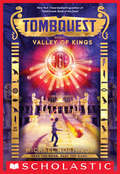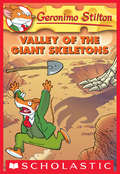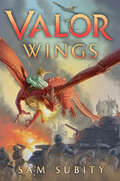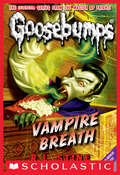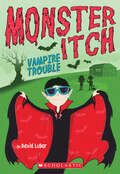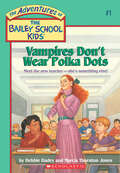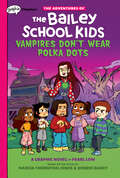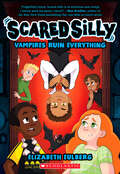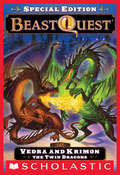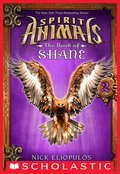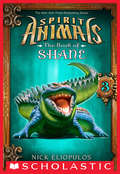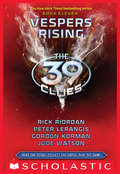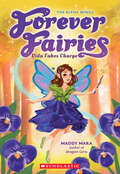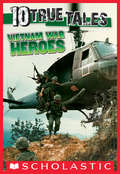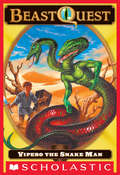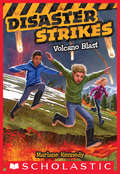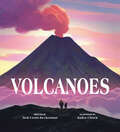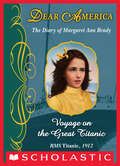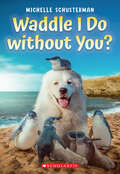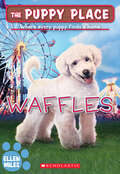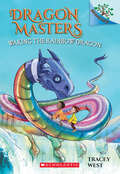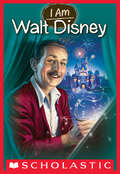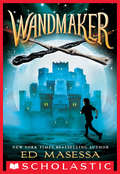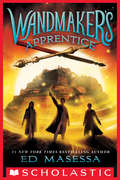- Table View
- List View
Valley of Kings (TombQuest #3)
by Michael NorthropFrom the author of the New York Times bestseller TombQuest:Book of the Dead comes the third in the epic Egyptian adventure series!If Alex and Ren are going to stop the Death Walkers, they know they have to find the powerful Lost Spells. So they head to the Valley of the Kings, deep in the Egyptian desert -- where they discover that Egypt is in the grips of madness. Voices in the air whisper dark secrets and flashes of light burn across the night sky. But their hunt for the Spells keeps getting sabotaged. Every step they take, The Order is hot on their trail. There's no dodging, no hiding. Is someone leaking their secrets?Is there anyone they can trust?Read the book by New York Times bestselling author Michael Northrop, then continue the adventure online! Build an Egyptian tomb of your own, hide treasure and protect it with traps, then challenge your friends!
Valley of the Giant Skeletons: Valley Of The Giant Skeletons (Geronimo Stilton #32)
by Geronimo StiltonEnter the world of Geronimo Stilton, where another funny adventure is always right around the corner. Each book is a fast-paced adventure with lively art and a unique format kids 7-10 will love.<P><p> Tuslaarai! Tuslaarai! That's Mongolian for "Help!" and holey cheese did I need some! I was lost in the Gobi Desert, looking for a hidden treasure. So far, all I had found were sandstorms, camels, and giant dinosaur bones? Rat-munching rattlesnakes - how do I get myself into these situations?<P> <i>Advisory: Bookshare has learned that this book offers only partial accessibility. We have kept it in the collection because it is useful for some of our members. To explore further access options with us, please contact us through the Book Quality link on the right sidebar. Benetech is actively working on projects to improve accessibility issues such as these. </i>
Valor Wings
by Sam SubityA thrilling WWII adventure that reimagines the evacuation of Dunkirk... with dragons!May 10, 1940Everyone in Iris's small English village avoids the dragon in the woods. Everyone, that is, except for Iris. She knows Galahad would never hurt her--she's been caring for the dragon since he lost his mother when he was a baby. When Galahad is accused of stealing military rations, Iris strikes a bargain that will spare Galahad's life... but send him off to the war brewing in Europe. Soon after, she receives news that her brother is among the troops trapped in France by the advancing German troops. Refusing to give up hope, Iris devises a desperate plan that will either save both her brother and her best friend--or end in disaster.Meanwhile in Belgium, Max's school day is abruptly interrupted by some terrifying news: The Germans have invaded his country. He and his grandmother are forced to flee for their lives west toward France where they hope to find safety. But when they are separated after a German attack, Max must continue the treacherous journey on his own.Across hundreds of miles, the stories of Iris and Max steadily converge toward an explosive conclusion that will change them both forever. Along the way, they each must find the inner strength and resolve--the valor--to do the impossible. Author Sam Subity blends history and fantasy to tell a story like no other--an exhilarating adventure about the power of friendship, hope, and courage.
Vampire Breath (Classic Goosebumps #21)
by R. L. StineGoosebumps now on Disney+!Tough. That's Freddy Martinez and his friend, Cara. They're not afraid of anything. But that was before they went exploring in Freddy's basement. Before they found the secret room. Before they found the bottle of Vampire Breath.Poor Freddy and Cara. They should have never opened that bottle of Vampire Breath. Because now there's a vampire in Freddy's basement. And he's very, very thirsty....
Vampire Trouble (Monster Itch #2)
by David LubarJust when Alex is getting close to the kickball home-run record at school, he starts getting hit with awful sneezing fits, completely messing up his game. He's allergic to a vampire! And the vampire won't leave. Can Alex and his cousin Sarah stop his horrible sneezes before they wreck recess -- permanently?
Vampires Don't Wear Polka Dots (Adventures of the Bailey School Kids)
by Debbie Dadey Marcia Thornton JonesThe hugely popular early chapter book series re-emerges -- now in e-book! The kids in the third grade at Bailey Elementary are so hard to handle that all of their teachers have quit. But their new teacher, Mrs. Jeepers, is different to say the least. She's just moved from the Transylvanian Alps and she seems to have some strange powers that help her deal with these mischief-makers. Her methods may be a little unconventional, but, then again, Mrs. Jeepers may be just what the Bailey School kids need.
Vampires Don't Wear Polka Dots: A Graphix Chapters Book (Adventures of the Bailey School Kids)
by Debbie Dadey Marcia Thornton JonesMrs. Jeepers may -- or may not -- be a vampire in this funny and spooky series from Graphix Chapters.Get drawn into reading with Graphix Chapters!Graphix Chapters are ideal books for beginning and newly independent readers aged 6-8. With approachable page counts, easy-to-follow paneling, and artwork that supports text comprehension, these engaging stories with unforgettable characters help children become lifelong readers.The third graders at Bailey Elementary are so hard to handle that all of their teachers have quit. But their new teacher, Mrs. Jeepers, is different -- to say the least. She's just moved from Transylvania into a spooky old house in Bailey City. She wears a mysterious brooch that glows as green as her eyes. Could Mrs. Jeepers be a vampire?Featuring a beloved story by Marcia Thornton Jones and Debbie Dadey and fresh artwork by Academy Award winner Pearl Low, Vampires Don't Wear Polka Dots is the first-ever graphic novel adaptation of Scholastic's classic chapter book series.
Vampires Ruin Everything (Scared Silly #3)
by Elizabeth EulbergGoosebumps meets The Baily School Kids in this young middle-grade series about four unlikely friends who must band together to save their town from an evil curse!WARNING: This book contains a very scary and silly story about a long dormant witch's curse that's been unleashed on the unsuspecting town of Cauldron's Cove. It's revenge, over three-hundred years in the making. (Hey, better late than never!)Regan, Sofia, Bennett, and Darius know better by now than to think the witch's curse is done with them. A mysterious family checks into Regan's family Boo and Breakfast...and they seem to take a particular interest in Regan! They're never seen during the day, they're allergic to garlic, and they speak like they're from another time.They couldn't be...could they? But why would a family of vampires want to recruit Regan?
Vedra and Krimon the Twin Dragons: Vedra and Krimon the Twin Dragons (Beast Quest Special Edition #2)
by Adam BladeA special edition Beast Quest-with twin baby dragons!New Beasts have been created in Avantia-- twin dragons Vedra and Krimon. But the Wizard Malvel plans to capture them, so Tom must take the dragons into hiding. Can Tom save the twin Beasts from the wizard's evil spell?
Vendetta: Special Edition) (Spirit Animals: The Book of Shane #2)
by Nick EliopulosThis trilogy of e-shorts shines a light on one of the most compelling--and dangerous--villains of the NEW YORK TIMES bestselling series. Now and then, to accomplish something great, you have to do something bad. Shane intends to end the conflict that's devastating Erdas... and to achieve that, he's just done something very bad. While returning home from a fateful victory, the young Conqueror discovers he's being pursued, and must seek cover in a war-torn jungle. But the forest holds dangers of its own, and before long Shane is fighting for his life. If he's going to win this war, Shane will need to outmaneuver a deadly pursuer -- and his own guilty conscience. Author Bio Nick Eliopulos is the author of Spirit Animals: The Book of Shane, a series of e-novellas set in the world of the bestselling multi-platform series. His short stories have appeared in Spirit Animals: Tales of the Great Beasts and Stuck in the Middle: Seventeen Comics from an Unpleasant Age. An avid fan of comics, games, and monster movies, he lives in Brooklyn and works in Manhattan as an editor of books for kids and teens.
Vengeance: Special Edition) (Spirit Animals: The Book of Shane #3)
by Nick EliopulosThis trilogy of e-shorts shines a light on one of the most compelling--and dangerous--villains of the NEW YORK TIMES bestselling series. The war is over and Erdas is rebuilding. It seems everyone is celebrating a new age of peace. Everyone except Shane. Shane wants revenge. The young Conqueror is on the hunt, tracking a target who knows his every move before it happens. He's closing in on his prey -- but the closer Shane gets, the more he begins to see patterns in the shadows. Shane can sense a trap is waiting. He's being led down a path that he may not be able to return from. Will he abandon his quest for vengeance . . . or follow it into the darkness? Author Bio Nick Eliopulos is the author of Spirit Animals: The Book of Shane, a series of e-novellas set in the world of the bestselling multi-platform series. His short stories have appeared in Spirit Animals: Tales of the Great Beasts and Stuck in the Middle: Seventeen Comics from an Unpleasant Age. An avid fan of comics, games, and monster movies, he lives in Brooklyn and works in Manhattan as an editor of books for kids and teens.
Vespers Rising (The 39 Clues #11)
by Gordon Korman Jude Watson Peter Lerangis Rick RiordanThe Cahills aren't the only family searching for the Clues. . . .The Cahills thought they were the most powerful family the world had ever known. They thought they were the only ones who knew about Gideon Cahill and his Clues. The Cahills were wrong. Powerful enemies -the Vespers- have been waiting in the shadows. Now it's their time to rise and the world will never be the same. In Vespers Rising, a brand new 39 Clues novel, bestselling authors Rick Riordan, Peter Lerangis, Gordon Korman and Jude Watson take on the hidden history of the Cahills and the Vespers, and the last, terrible legacy Grace Cahill leaves for Amy and Dan.
Vida Takes Charge (Forever Fairies)
by Maddy MaraJoin the four Alpha Wings on their adventures in the Magic Forest! These Forever Fairies will need to do all they can to help save the day.Welcome back to the Magic Forest!Flying fever is spreading around the Forever Tree, and the Alpha Wings need to find a cure quickly! Vida and her friends only have one hope—travel farther into the Magic Forest and ask the mysterious Beast of Many Wings for help. But Serpentina, the evil snake spirit, is still trying to stop them at every turn. The fairies will have to work together to stay safe. Will they be able to heal everyone before the Midblossom Ball?
Vietnam War Heroes (Ten True Tales)
by Allan ZulloTen true stories of real-life heroes of the Vietnam War!Twenty-eight soldiers--all but five badly wounded or dead in the first few minutes of a devastating ambush--are fending off 200 North Vietnamese soldiers. US platoon leader Lieutenant Hal Fritz shouts to his comrades, "We will never give up!"Dozens of severely wounded soldiers are trapped in a fog-shrouded outpost and under merciless attack by the enemy. No other medical helicopter pilot will dare attempt a rescue, except for Major Patrick Brady. These and other American heroes risked their lives serving their country in the Vietnam War. You will never forget their courageous true stories.
Vipero the Snake Man (Beast Quest #10)
by Adam BladeOne boy's journey to save his village becomes a quest to save the Kingdom.Setting out on the next stage of the Quest is harder than ever-it means leaving home. Tom successfully defended his village, but an even more sinister Beast waits on the horizon: Vipero. Tom has no choice but to leave his family once again, bound for the desert and its untold dangers.
Volcano Blast: Volcano Blast (Disaster Strikes #4)
by Marlane KennedyWhen disaster strikes, the only thing you can count on is yourself!Noah and Emma Burton have traded the sand and surf of their Hawaiian home for a chilly stay in Alaska, and Noah isn't happy about it. His father may be a volcano expert, but why did they have to travel to the coldest, grayest place on earth when there are millions of volcanoes near Honolulu? Noah thinks he's in for the most boring vacation of his life.He couldn't have been more wrong! A day trip to a remote island turns deadly when a once-dormant volcano suddenly sputters to life in an eruption of epic proportions. Now Noah, Emma, and their new neighbor Alex must fight to survive rivers of molten lava and clouds of toxic ash if they want to make it off the island alive....
Volcanoes
by Nell Cross BeckermanThe team behind the acclaimed book Caves returns with an enticing exploration of one of the most explosive wonders on the planet--Volcanoes!A rumble. A tremble. A grumble. Growing, growling, getting hot. When will it...POP?!Using evocative storytelling, Nell Cross Beckerman leads children on an adventure through the radioactive wonders that are volcanoes. From deep down on the ocean floor to extraterrestrial volcanoes, Beckerman guides readers with dramatic, poetic language. Nonfiction text on every page allows for deeper understanding of the topic.Illustrator Kalen Chock's stunning illustrations have been praised as "atmospheric" and "striking," and readers will be delighted as each new page brings a new surprise. Extensive backmatter includes an author's note, additional information on the types of volcanic eruptions and the questions volcanologists are trying to answer, and additional facts. An ideal choice for nature lovers, future explorers, and fans of Jason Chin and Kate Messner.
Voyage On The Great Titanic: Voyage On The Great Titanic (Dear America)
by Ellen Emerson WhiteOne of the most popular Dear America diaries of all time, Ellen Emerson White's bestselling VOYAGE ON THE GREAT TITANIC is now back in print with a gorgeous new package! Five years ago, Margaret Ann Brady's older brother left her in the care of an orphanage and immigrated to America. When the orphanage receives an unusual request from an American woman looking for a traveling companion, Margaret's teachers agree that she is the perfect candidate to accompany Mrs. Carstairs on the TITANIC, so that once Margaret arrives in New York she will be free to join her brother in Boston. But the TITANIC is destined for tragedy, and Margaret's journey is thrown into a frozen nightmare when the ship collides with an iceberg.
Waddle I Do without You?
by Michelle SchustermanWhen a local -- and rare -- penguin population is threatened, it's up to a girl, a dog, and a penguin to protect the colony from danger, in this heartwarming story of friendship and teamwork by Michelle Schusterman!Penguin Island is known for being home to a rare population of fairy penguins, separated from the mainland by a narrow strip of land. Trouble is, that strip of land becomes exposed during low tide, and a local pack of foxes has discovered it!When twelve-year-old Addie Jenkins realizes how vulnerable the penguins are, she decides to take action with Max, her faithful and protective sheepdog, by her side. Max becomes the colony’s protector, keeping the foxes at bay and teaching the penguins how to defend themselves. But Darwin, a young and rambunctious penguin, doesn’t trust Max, and the two can’t seem to agree over what’s best for the colony. That’s when a bad thunderstorm strikes, leaving the penguins suddenly alone and without protection. Will Max and Darwin be able to set aside their differences and work together to save the colony?
Waddle! Waddle!
by James ProimosWhat's a penguin to do when he can't find his new friend? Yesterday he made a friend who was an absolutely amazing dancer--but now he can't find him anywhere! Waddle...waddle...bellyslide! along with this hopeful penguin as his search for his new friend takes him on some zany adventures--and ultimately, to an unexpected and heartwarming conclusion. Acclaimed creator James Proimos, illustrator of Year of the Jungle by Suzanne Collins, brings his zest and zany humor to this charming friendship story.
Waffles (The Puppy Place)
by Ellen MilesWelcome to the Puppy Place! Where every puppy finds a home. Charles and Lizzie Peterson love puppies. Their family fosters these young dogs, giving them love and proper care, until they can find the perfect forever home.Waffles is exuberant, playful, and smart – maybe too smart! She’s quite the escape artist and Lizzie has her hands full trying to keep tabs on her.
Waking the Rainbow Dragon: A Branches Book (Dragon Masters #10)
by Tracey West Damien JonesDragon Masters Drake and Ana travel to a new land in search of the Rainbow Dragon!Pick a book. Grow a Reader!This series is part of Scholastic's early chapter book line, Branches, aimed at newly independent readers. With easy-to-read text, high-interest content, fast-paced plots, and illustrations on every page, these books will boost reading confidence and stamina. Branches books help readers grow!In the tenth book in this series, Drake has a strange dream about a Rainbow Dragon trapped in a cave. He wonders if the dream could be real... Is the dragon trying to send for help? Griffith the wizard uses the magical Dragon Stone to find out more -- and a new Dragon Master is revealed! Drake and Ana must travel far in search of the new master and his dragon. But how will they find the secret cave from Drake's dream? And why is the Rainbow Dragon trapped there? The Dragon Masters have a tough battle ahead of them!
Walt Disney (I Am #11)
by Ms. Grace NorwichI am the creator of Mickey Mouse. I am Walt Disney.As a child, I had a wild imagination and a great curiosity. As I grew up, I used those qualities to become a cartoonist. Eventually, I turned these drawings into films and began my own animation business. One of my characters, Mickey Mouse, became so popular that movie theaters sold out and I won an Academy Award. After pursuing a career as a film producer, director, screenwriter, voice actor, entrepreneur and entertainer, I added developer to my resume when I created Disneyland amusement park. I became tremendously successful and beloved by children of all ages because of my belief that even the impossible is possible. I am Walt Disney.To this day, Walt Disney's characters remain some of the most recognizable images in the world. With books, TV shows, films, and amusement parks devoted to his creations, the Walt Disney name lives on. Learn all about this remarkable man's fascinating life in Scholastic's biography series, I AM.
Wandmaker
by Ed MasessaMagical fiction from the author of the #1 New York Times bestselling Wandmaker's Guidebook!Magic is real -- and it runs in the family -- in this charming fantasy adventure about a boy who must balance his magical education with the demands of big-brotherhood, perfect for fans of Jenny Nimmo and Angie Sage.Henry Leach the Eighth doesn't know it yet, but he's descended from a long line of wandmakers. That means he has inherited mysterious powers, a trunk full of strange artifacts... and a whole host of problems.His biggest problem at the moment, however, is his little sister, Brianna. She's always had a special talent for getting in his way. And she takes troublemaking to new heights when she's caught in the crossfire of Henry's first major spell!Heartfelt, funny, and imaginative, Wandmaker is sure to leave young readers spellbound.
Wandmaker's Apprentice
by Ed MasessaHenry Leach the Eighth and his sister, Brianna, have survived a faulty spell, defeated a wicked spellcaster, and saved the world . . . but their greatest accomplishment might be convincing Grand Wand Master Coralis to take them on as official apprentices.For the first time in centuries, the reclusive Wand Master has opened the doors to his castle and invited a new generation of Wandmakers to learn the secrets of the craft. But danger lurks around every corner in a world of magic, curses, and fantastical beasts. And the greatest threat of all may come from within the Wandmakers' own ranks.Perfect for fans of Harry Potter and Charlie Bone, the Wandmaker series puts a humorous spin on magical coming-of-age stories.
